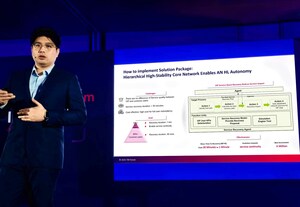Huawei Launches Inaugural Asia/Pacific Ultra Broadband Summit with Goal of Creating a More Connected Asia/Pacific
NEW YORK, Aug. 3, 2015 /PRNewswire/ -- In early July, Heavy Reading Senior Analyst Sterling Perrin, hosted Huawei's first-ever Asia/Pacific Ultra Broadband Summit, which took place in Bangkok, Thailand, and drew more than 400 telecom leaders from throughout Asia/Pacific, including from India, Bangladesh, Cambodia, Vietnam, Nepal, Australia, Singapore, Malaysia and Thailand. Regional efforts to meet aggressive plans to roll out broadband services were the focus of Huawei's Ultra Broadband Summit, with the goal of working toward ways of achieving the ITU's Connect 2020 agenda. ITU Connect 2020 calls for connecting 55% of home users to the Internet and achieving 90% coverage in remote areas (including wireline and wireless) by 2020. Achieving these goals will require significant cooperation and investment among governments, network operators and equipment suppliers.
The Asia/Pacific Ultra Broadband Summit focused specifically on the role of fixed broadband networks in this future, with the spotlight on two main sub-themes within the conference: driving affordable fixed broadband penetration across developing nations, primarily through adoption of national broadband network policies and strategies; and moving from today's fixed broadband rates to next-generation ultra-broadband rates of 100 Mbit/s or higher in developed nations.
"Developing nations have been rapid adopters of mobile technologies, to tremendous benefit for those countries and their citizens," noted Sterling Perrin, senior analyst at Heavy Reading and a lead presenter at the event. "Yet there was general agreement at the Summit that mobile broadband alone is not sufficient for Asia/Pacific nations to achieve their broadband goals because mobile data speeds do not compare to fixed broadband speeds -- particularly when looking at fiber optics or next-generation copper advancements, such as G.fast."
Developed economies -- such as South Korea and Japan -- are building their next-generation broadband networks on top of already well-established infrastructures, but developing nations in Asia-Pacific have very limited fixed networks.
However, there is also an opportunity for developing nations to leapfrog technologies and move directly to the best and most advanced fixed technologies available -- such as GPON/FTTH, said Daniel Tang, CTO of Huawei's fixed network business unit. Developed nations are often forced to continue to invest in their legacy copper networks, because the installed base is so large, even though copper is inferior to fiber and very costly to maintain. This is the greenfield builder's advantage, according to Tang.
The main challenge ahead is less about technology than finding the money and the overall commitment to building out fixed broadband networks more aggressively, Perrin added. "Leading-edge nations have already shown that 100 Mbit/s or even gigabit fixed broadband speeds are achievable with current technology," he explained. "While heads generally nodded in agreement about the economic and quality-of-life benefits of national broadband networks and an ultra-broadband future, the real challenges of finance and execution need to be tackled before 2020."
Additional information on Huawei's Ultra Broadband Summit in Asia can be found here: http://www.lightreading.com/gigabit/ultra-broadband/an-ultra-broadband-future-for-asia-pac/a/d-id/717291





Share this article